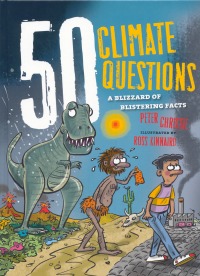| ________________
CM . . . . Volume XVIII Number 30 . . . . April 6, 2012
excerpt:
50 Climate Questions: A Blizzard of Blistering Facts looks at climate change, both current and historical, from how climate affects us now to the effects climate has had on the history of humanity and on the history of the Earth. Presented in an easy-to-read format with plenty of humor, 50 Climate Questions covers a variety of topics without overwhelming readers. As with other books in the "50 Questions" series, this book is broken into chapters, with a few questions per chapter. Each question acts as a humorous opening to the topic being covered. This makes the information very accessible since the questions are organized rather than being presented randomly. The excellent detailed index will also aid readers in finding information. This information is presented in a humorous but well organized and east-to-read fashion. As can be seen from the excerpt, topics are discussed in language that is understandable to most readers, with a minimal use of jargon. Necessary terms are explained for the reader within the text. There is no glossary, but one is not particularly necessary. The humorous illustrations do not add much information but make this book fun as well as educational. A lot of information has been covered in 50 Climate Questions. There are a number of boxes of quick facts and other information that supplements the main text. However, the format of this book limits the coverage of each topic. Readers can still learn a lot from this book, and the "Further Reading" section gives a number of good resources for readers who want to look up more on individual topics. 50 Climate Questions is a humorous, appealing, and informative look at climate change that can be enjoyed whether one is looking for a recreational read or for information for a school project. Highly Recommended. Daphne Hamilton-Nagorsen is a graduate of the School of Library, Archival and Information Studies at the University of British Columbia, Vancouver, BC.
To comment
on this title or this review, send mail to cm@umanitoba.ca.
Copyright © the Manitoba Library Association. Reproduction for personal
use is permitted only if this copyright notice is maintained. Any
other reproduction is prohibited without permission.
NEXT REVIEW |
TABLE OF CONTENTS FOR THIS ISSUE
- April 6, 2012.
AUTHORS |
TITLES |
MEDIA REVIEWS |
PROFILES |
BACK ISSUES |
SEARCH |
CMARCHIVE |
HOME |
